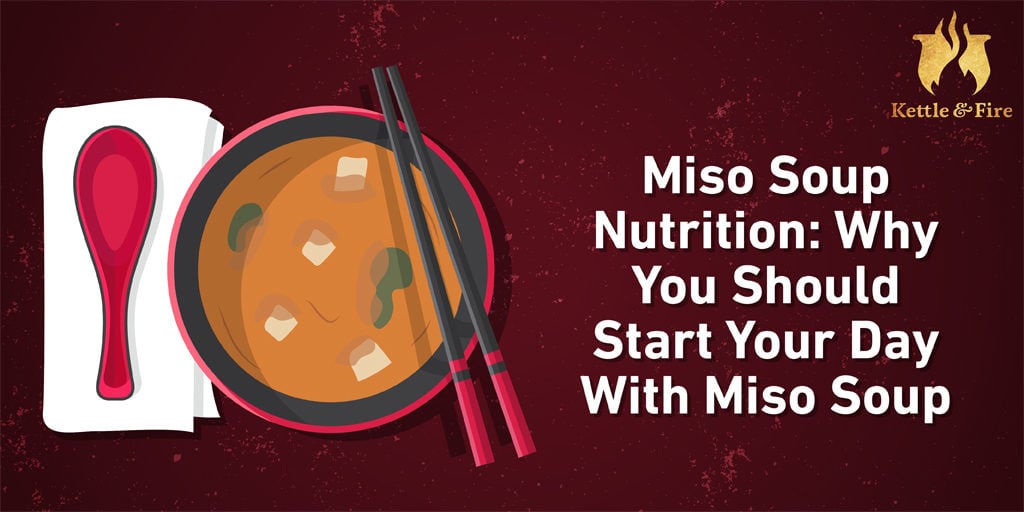Miso Soup Nutrition: Why You Should Start Your Day With Miso Soup

Have you ever wondered what’s in the little bowl of soup you get before your meal at Japanese restaurants? Sure, you know it’s called miso soup, but what’s in it, besides a few cubes of tofu, spring onions, and some leaves of seaweed? What gives it its distinct flavor? What’s the stuff that sinks to the bottom, and why is it so salty? Why bother eating such a tiny amount of soup anyway?
Miso soup is placed in front of you at the beginning of your meal because it contains enzymes that will help you digest your food. Not only that, miso has its own nutritional merits, standing alone as a powerhouse of vitamins, minerals, and other phytochemicals.
As a fermented food, it also contains probiotics, helpful bacteria that help to support overall gut health. Incorporating miso into your diet beyond an occasional bowl before your sushi dinner could be a great way to incorporate more nutrient-dense foods into your meal plan and might even help you lose weight (1).
How It’s Made
Miso paste is the base for miso soup and other miso products, such as salad dressings, marinades, and even some desserts. The paste is the product of a fermentation process using rice, barley, or buckwheat along with cooked soybeans, lots of salt, and an activating agent called Aspergillus oryzae. Aspergillus oryzae is a type of fungus that’s responsible for the nutrient density of the end product. When used in the fermentation process to create the base for miso paste (called koji), Aspergillus oryzae produces enzymes that aid in digestion (2).
Fermentation takes place when microorganisms (fungi and bacteria) feed on the sugars found within the grains and beans in koji, partially digesting constituents in the food that might be more challenging for humans to digest. In other words, this process helps make certain nutrients more bioavailable and digestible than they would be if you were just eating a bowl of rice or soy beans. The fermentation is where the magic happens, turning grains and beans into a delicious food containing vitamins and minerals and culturing beneficial bacteria that will help nourish the gut and support the immune system.
What Is Miso Soup?
The standard Japanese recipe for miso soup is extremely simple. It’s the combination of miso paste, a few cups of water, cubed firm tofu, shiitake mushrooms, green onions, and wakame seaweed. While some of the accompaniments might change or be left out, the main ingredients (miso paste, water, tofu, seaweed) always stay the same.
To make miso soup, it’s important that the water not be boiling when you add the miso paste, otherwise the beneficial bacteria won’t survive. It’s a very quick cook time in general for all miso soup recipes, with everything being added in after the water has cooled from boiling.
If you plan to make your own miso soup at home and some of the ingredients we mentioned aren’t familiar to you, you might want to seek out an Asian market to do your shopping. That being said, most standard American markets do have brown or red miso paste and fresh tofu in the refrigerated section.
Miso paste lasts for a long time in your refrigerator and adds a lovely umami depth to a standard soup stock, whether you’re making chicken stock, vegetable stock, or something else. Many grocery stores even carry instant miso soup in the same aisle as instant ramen noodle soups, instant dashi, and other freeze dried options.
Miso Soup Nutrition Facts
As far as macronutrients go (carbohydrates, fats, proteins, and calories), miso is a relatively low-impact food. You only need a small amount to add to hot water (not boiling, as boiling will kill the helpful bacteria and neutralize the enzymes).
A one-ounce serving of miso paste gives you an average of 56 calories, 2 grams of total fat, 3 grams of protein (amino acids), and 7 grams of total carbs (3). Due to these relatively low numbers, miso can be a great addition to a low calorie diet.
Miso soup contains micronutrients, from the enzymes and probiotics we’ve already mentioned to a host of vitamins and minerals. Miso contains:
- Vitamin A
- B vitamins — vitamin B12, pantothenic acid (B5), niacin (B3), thiamin, riboflavin, B6, and folate
- Vitamin K
- Choline
- Calcium
- Manganese
- Potassium
- Copper
- Zinc (4, 5)
Each of the above listed vitamins and minerals vary in their percent daily values, but taken together, may offer beneficial nutrients and health benefits in an easy-to-consume package.
Miso also contains phytochemical antioxidants, which can increase in quantity the longer the fermentation time (at least four months). Antioxidants gobble up free radicals in the body, which create disease, signs of aging, cell death, and even cancer (cell mutation).
Eating a diet rich in a variety of antioxidants (including vitamins, minerals, and phytonutrients) may contribute to your overall health and wellness, in addition to offering protective qualities to stave off aging and inflammation. Miso boasts a good number of these chemicals, including flavonoids, isoflavones, phenolic acids, saponins, phytosterols, and others (5). Saponins, in particular, and miso in general, have been studied for their protective quality against certain cancers, including lung, colon, stomach, and breast cancers (3).
What About Sodium?
We mentioned that a lot of salt is required to properly ferment the various ingredients in miso paste. This is because salt acts as a natural preservative, protecting the koji culture from being overly infiltrated by fungus.
In other words, the salt keeps the fermentation process slow and steady, and you can’t make miso soup without it.
One ounce of miso contains over 1000 milligrams of sodium, which you would think would ring alarm bells for your health care professionals. But in fact, both human and animal studies have shown that there’s something special about miso.
A study of over 40,000 Japanese subjects spanning over 10 years showed that miso, despite its high sodium content, had a protective effect against certain cardiovascular diseases (5). It didn’t seem to cause hypertension the way high doses of sodium ordinarily would, either.
Animal studies comparing the same sodium consumption from table salt vs. miso have repeatedly demonstrated that miso affects the body differently than table salt (6).
How to Add Miso Soup to Your Diet
Now that you’re convinced that miso soup can be a healthy addition to your diet, you might be asking where you can find it.
Miso paste is available in most grocery stores in the refrigerated section. Look for miso paste that has been aged for at least four months (this is typically the yellow, brown, or red variety, rather than the white miso) to maximize the health benefits.
You want to make sure that the product is not pasteurized (otherwise the beneficial enzymes and bacteria will be lost), and that the ingredients meet your particular dietary standards. Buckwheat, rice, and soy are gluten free, but barley isn’t, so if you’re following a gluten-free diet, be sure to select a miso paste that doesn’t include barley koji. Since soy grown in America is somewhat controversial due to unsustainable farming practices, you’ll also want to search for an organic or non-GMO brand of miso to avoid consuming unnecessary chemicals.
Miso can be added to salad dressings, marinades, and even your daily bone broth. Follow the guidelines on the tub of paste you purchase to make miso soup properly (without harming the beneficial bacteria inside). It will last in your refrigerator for a long time, so get into the practice of using a small amount every day.
Miso has been part of a traditional diet in many Asian countries for good reason. It’s nutritious, contains vitamins, minerals, and phytonutrients without having a huge impact on macronutrient intake. It’s traditionally consumed at breakfast or before a meal to help jumpstart your metabolism and prepare your body for food digestion. Give it a try, and see what you think!
Pin for later:










